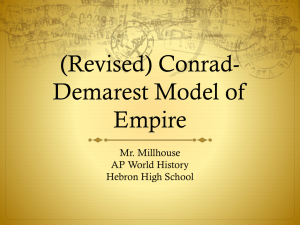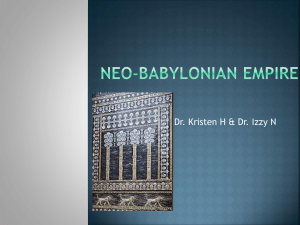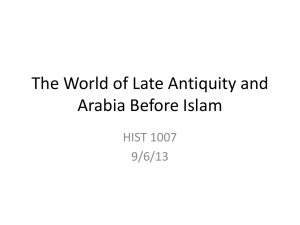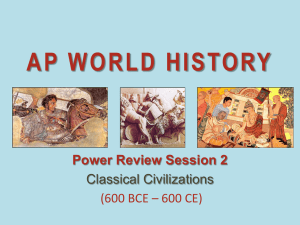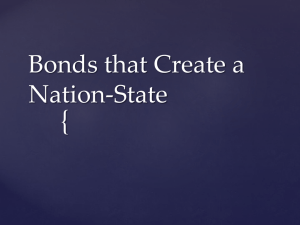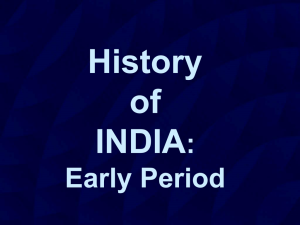The great empires of the Mediterranean… 3000 BCE
advertisement
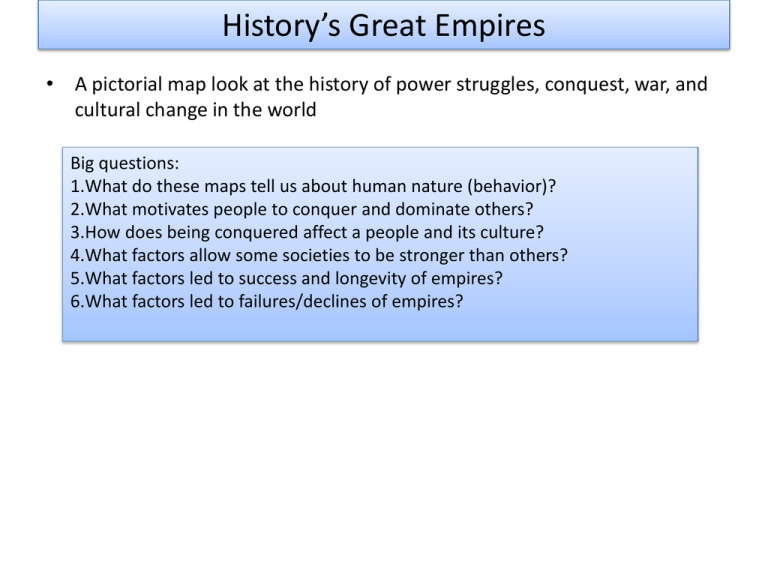
History’s Great Empires • A pictorial map look at the history of power struggles, conquest, war, and cultural change in the world Big questions: 1.What do these maps tell us about human nature (behavior)? 2.What motivates people to conquer and dominate others? 3.How does being conquered affect a people and its culture? 4.What factors allow some societies to be stronger than others? 5.What factors led to success and longevity of empires? 6.What factors led to failures/declines of empires? Some of the many great empires of the Mediterranean… 3000 BCE—1900s CE 1. Ancient Egypt (circa 3000 BCE-30 BCE) 2. Babylonian (Sumerian) Empire (circa 2000 BCE-1500 BCE; 612 BCE-539 BCE) 3. Assyrian Empire (circa 850 BCE-600 BCE) 4. Persian Empire (circa 550 BCE- 350 BCE) 5. Greek/Macedonian Empire (circa 340 BCE – 300 BCE) 6. Roman Empire (circa 200 BCE-500 CE) 7. Byzantine Empire (500 CE-1453 CE) 8. Umayyad Caliphate Empire (circa 650 CE- 750 CE) 9. Ottoman Empire (circa 1288 CE-1922 CE) 1. Hypothesize 3 reasons that so many of the world’s great empires were located near the Mediterranean Sea. Use the map and your knowledge of how physical geography influences societies to make your guesses! 2. Make a 2-column list that sorts the 9 empires into short lived (less than 300 years) and long lived (greater than 300 years). Hypothesize 2 reasons why some of the empires were short lived while others lasted a long time. 1. Ancient Egypt Kingdoms along Nile River valley unified under rule of supreme leader (Pharaoh) circa 3000 BCE Flourished as a distinct culture ruled by Pharaohs until about 30 BCE despite numerous invasions by Kushites (Nubians) from south, Persians and Assyrians from northeast, and Macedonians (Greeks) & Romans from north. Babylonian Empire (Mesopotamia) Famous for: Hammurabai’s Code, Tower of Babel (Biblical site, was it real?), King Nebuchadnezzar, enslavement of Jews, Hanging Gardens palace… Assyrian Empire (Mesopotamia) Famous for: Strong, savage military. Attacks on Jerusalem (referenced in Bible)… Persian Empire (map circa 500 BCE) Government leaders (Cyrus, Darius) known for tolerance, kindness to conquered peoples, and being good political as well as military leaders. Quick write: 1.What are 2 possible reasons a leader would try to control so much territory as Cyrus and Darius did? 2.What are 2 things that might have influenced Darius’ and other Persian leader’s decisions of what land to conquer? 3.Name 2 things a leader would need in order to continue expanding his empire. 4.What might be a negative affect on the empire of having so much territory? Classical Greece (approx 2000 BCE- 350 BCE) and Macedonian (AKA Greek) Empire (approx 340 BCE- 300 BCE) Macedonian Empire circa 320 BCE Classical Greece (collection of city-states) Macedonian Empire created by General Alexander III the Great and his father, Philip Quick write: Make a list of all the things that come to mind when you think of Classical (some call it Ancient) Greece or Greek empire. Persian Empire circa 500 BCE Macedonian (AKA Greek) Empire circa 320 BCE) Quick write: 1.Describe any similarities and differences you see between the 2 maps (and I don’t mean in terms of color or font!!) 2.What can you infer happened in the area of the map between 500 BCE and 320 BCE? 3.Hypothesize 2 ways people’s lives in the shaded areas may have changed or been impacted when the territories transitioned from Persian rule to Macedonian/Greek rule. Time lapse of growth of Roman Empire (44 BCE – 180 CE) gbgm-umc.org/UMW/corinthians/empire.stm Quick write: 1. Hypothesize 2 reasons why the Roman army was able to conquer so much land, including areas that had once been under the control of mighty Assyrian, Persian, and Macedonian empires. 2. Name 2 religions you think were being practiced by peoples in the orange (44 BCE) and green (14 CE) territories when the Romans took control. Byzantine Empire Growth and Decline 527 CE – 565 CE Emperor Justinian “gets back” Italy, southern tip of Spain and north coast of Africa, regaining some of the former Roman Empire territories from Christian Vandals 1,100 CE •Peach territories lost to Islamic expansion •Yellow territory (southern Italy) lost to the Normans (from the northern coast of France) Umayyad Caliphate Empire (circa 650 CE- 750 CE) http://www.mideastweb.org/Middle-East-Encyclopedia/umayyad.htm •fifth largest contiguous empire in history •estimated to be the third largest by population, encompassing about 30% of the world's population. Ottoman Empire at its pinnacle (circa 1580 CE) Time lapse expansion of Ottoman Empire Quick write: Based on the multiple colors representing expansion over time, what can you infer about the Ottoman Empire in terms of: •Government organization and power •Army & technology •The wealth of the government/empire Time lapse decline of Ottoman Empire Quick write: Describe the geographic power shift this map depicts that took place in the 1800s and early 1900s. Other kickin’ empires around the world… 1200s CE Genghis Khan, Kublai Khan create largest contiguous empire (in terms of territory) in history of world (Great Britain’s empire contained more territory, but was not all connected) Quick write: Describe the impacts of the Mongol Empire on the cultures of the conquered territories. Gupta Empire (320 CE- 550 CE) • • • Holy Roman Empire (800 CE- 1806 CE) Pope in Rome anoints kings within the territory as emperor of Holy Roman Empire Creates more formal division and rivalry between west and east (Rome vs. Constantinople’s Emperor of Byzantine Empire) and the Orthodox and Catholic churches For 1000 years power struggles between Holy Roman and Pope Ruled by Russian Czars (Tsars) until Bolshevik Revolution (civil war) of 1917 turned Russian Empire into Soviet Union (Colors represent year that territory was acquired) Qing Dynasty (China 1644 CE – 1911 CE) Monarchy ruled by emperors until revolution in 1911, led by Sun Yat-sen, turns China into republic, until Communists led by Mao Zedong take control in 1949. Austro-Hungarian Empire (AKA Habsburg Empire) 1867-1918 •Essentially replaces Holy Roman Empire. •Empire dissolves after losing WWI and being broken apart by the winners “To the victors go the spoils” Let’s not forget the empires created by European imperialism! and colonialism!


